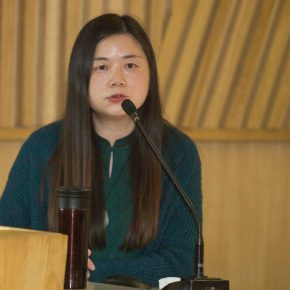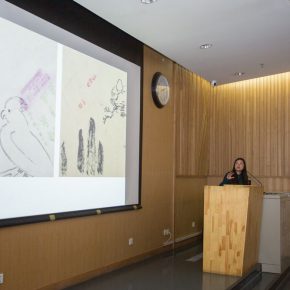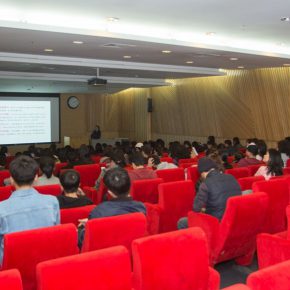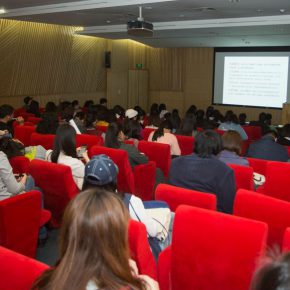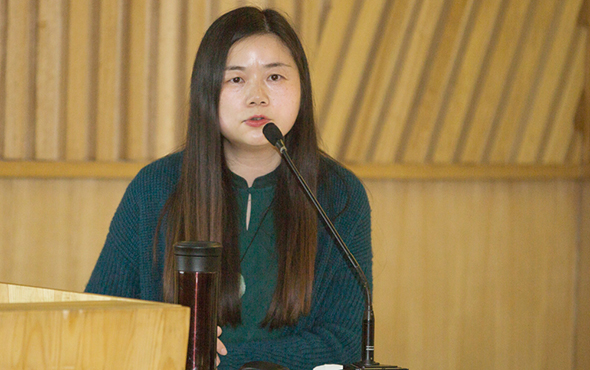
At 14:00 on March 31, 2017, held by the School of Humanities, CAFA, “Grinding a Rough Stone to Jade, Self-Manuscripts: Seeing the Creation of Qi Baishi from the Manuscripts” was held at the Red Chair Lecture Hall of Building 7. The speaker of this lecture is the researcher Lv Xiao, Director of the Theory Research Department of Beijing Fine Art Academy and the Secretary-General of Qi Baishi International Research Center for Art. The lecture was hosted by Wu Xueshan, a teacher from the School of Humanities, CAFA.
This lecture started from Qi Baishi’s drawings to talk about the creative process of the artist which is presented to the audience for the first time, so the audience can see the sketching process and even the experiences of learning to paint. The whole lecture is divided into four parts: Transferring and Replication, Sketching, Seeing with Eyes and Learning by Heart, and Self-Manuscripts. When the speaker prepared “Life is Short – Qi Baishi’s Manuscripts Collectedby Beijing Fine Art Academy”, Qi Baishi’s manuscripts were divided into four categories, and this lecture also unfolded in accordance with this order.
At the beginning of the lecture, the speaker Lv Xiao first introduced the situation of Qi Baishi’s paintings which were collected by the Beijing Fine Art Academy. Lv first introduced the “Qi Baishi Complete Works” published by Beijing Fine Art Academy and the late publication of the offprint “Living in the Grasses – Grass and Insect World under the Brush of Qi Baishi”, “Red Traces of Qi Baishi’s Three Hundred Stones” and “Life is Short – Qi Baishi’s Manuscripts Collected by Beijing Fine Art Academy”, which introduces the theme of this lecture – Qi Baishi’s manuscripts. The speaker then uses the manuscripts of the four types –Transferring and Replication, Sketching, Seeing with Eyes and Learning by Heart and Self-Manuscripts, to prove that different works have been made with different adjustments in Qi Baishi's painting career.
The first part is the “Transferring and Replication”, where it collects the copies of predecessors’ paintings by Qi Baishi, including double manuscripts which strictly following the original drafts, as well as the free-style copies of the drafts. When Qi learned painting, he started copying the “Manual of the Mustard Seed Garden”, and learned early on from the famous local painters Hu Qinyuan, Huhe Guangbing, etc., and he came into contact with the works by Badashanren, Jin Nong, Meng Litang, Li Shan, Luo Pin, and even the figure paintings by Tang Yin and Wang Juzheng during his travels. During the Declining-Year Reforming, Qi Baishi studied the contemporary masters in depth especially Wu Changshuo, constantly learning about it as he aged and even modestly absorbed the advantages of his students. Qi Baishi transferred and replicated the paintings that he loved and he preferred the system of doubling with copying, re-creating it after copying. In addition, Qi Baishi usually appreciated a work by copying it rather than adding it to a collection. The habit of copying instead of the collection made Qi Baishi selectively absorb the advantages of the tradition, so as to avoid his obsession with the ancient classics which was conducive to his creations.
Part 2 is “Sketching”, where the majority of his drawings are sketches and manuscripts of flowers and trees, grasses and insects, birds by Qi Baishi during his travels. Qi Baishi himself also said that he liked to draw small animals and insects, while he avoided using unfamiliar things as the theme. Qi Baishi travelled to many places in the prime of his life, for example, Guangdong and Guangxi regions, his favorite ones were the landscapes of Guilin area, so the steep Guilin landscapes were added to the painting. For the manuscripts of the works of Qi Baishi, compared to the finished works, there were a lot of textual labels added, such as marking the color, location and so on. Qi was famous for painting shrimps, and on the table, Qi Baishi placed a large bowl with fish or shrimps, Qi constantly observed and painted, spending more time in feeding and researching small animals than drawing. Comparing the shrimps drawn in different times, one can also see the progress and the later shrimps are more similar in spirit and clearer than the early ones, and they are more thoroughly understood than the early ones in the structure.
In the part 3 of “Seeing with Eyes and Learning by the Heart”, drawings are presented painted by Qi Baishi from memory or the person who he met, or the favorite things that he could not afford, “Seeing with Eyes and Learning by the Heart” is a special method of artistic style for Chinese painting and the objective is the observation of nature, which was also often applied by Qi Baishi in his drawings.
In part 4 of “Own Manuscripts”, it dominates the majority of the manuscripts displayed at the show, which reflects the creative process of Qi Baishi who had repeatedly scrutinized the work. For the manuscripts collected by Beijing Fine Art Academy, it is dominated by the “self-manuscript”, and the time spannedfrom the period of Qi Baishi’s forty years of traveling to the last glorious moments of life and art after the founding of the PRC. Comparing these manuscripts to formal works, we can see the process of Qi Baishi which started from learning from his predecessors to create his own work, as well as the process of repeated scrutiny and continuous modification in the creative process.
Finally, the speaker Lv Xiao offered a warm exchange with the students and the host, and the lecture ended.
Text by Lai Yaqian, translated by Chen Peihua and edited by Sue/CAFA ART INFO
Photo by Hu Sichen/CAFA ART INFO



